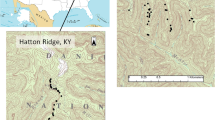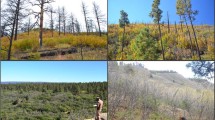ABSTRACT
We present a regional–historical approach to the interpretation, conservation, and management of pitch pine–scrub oak (PPSO) communities in the Connecticut Valley of Massachusetts. Historical studies, aerial photographs, GIS analyses, and extensive field sampling are used to (a) document changes in the historical distribution, composition, and dynamics of these communities, and (b) evaluate the importance of regional–historical approaches to understanding, conserving, and managing uncommon communities. At the time of European settlement, pine plains dominated by both pitch and white pine were widespread, occurring on 9000 ha or more of the extensive (approximately 32,000 ha) xeric outwash deposits in the Connecticut Valley. Pine plains were harvested for diverse forest products from the 17th to the early 19th centuries. After 1830, most sites were cleared and plowed for agriculture and then abandoned in the late 19th and early 20th centuries, resulting in widespread natural reforestation. Modern PPSO communities differ from historical communities with respect to landscape distribution, composition, and structure. Nearly all modern pitch pine stands in the Connecticut Valley became established on former agricultural fields. Current vegetation on these former fields differs substantially from those few sites that were never plowed. In particular, several species (for example, Gaultheria procumbens, Gaylussacia baccata, Quercus ilicifolia, and Q. prinoides) that are characteristic of unplowed sites have not successfully colonized former fields in the 50 to more than 100 years since agricultural abandonment. Urban, commercial, and residential development have been widespread in the 20th century. By 1985, only 38.6% of the outwash deposits remained forested, and only 1094 ha of pitch pine stands and 74 ha of scrub oak stands occurred, primarily in numerous small patches. Several stands have been destroyed since 1985, and development threatens all remaining sites. The trend towards rapid urban development in the 20th century makes it increasingly urgent that the few, relatively large, undeveloped sites be protected. Our results suggest that (a) land protection efforts should prioritize large, undeveloped sand plains, areas that were not plowed historically, and reestablishment of contiguity between isolated sites to facilitate colonization of former agricultural lands by sand plain species; (b) management of PPSO communities should not be restricted to maintenance of open barrens; “old-growth” pitch and white pine stands occurred historically, and some PPSO communities should be allowed to mature without frequent disturbance; (c) the exclusive use of prescribed fires during the spring months is unlikely to maintain communities similar to modern ones or to restore communities similar to historical ones. Establishment or maintenance of open barrens species and communities may require more varied disturbance regimes, perhaps including mechanical treatment in combination with prescribed fire to simulate severe summer fires; (d) regional–historical perspectives are critical for understanding modern community dynamics and for evaluating conservation objectives and management strategies for uncommon plant communities.
Similar content being viewed by others
Author information
Authors and Affiliations
Additional information
Received 10 March 1998; accepted 9 March 1999.
Rights and permissions
About this article
Cite this article
Motzkin, G., Patterson III, W. & Foster, D. A Historical Perspective on Pitch Pine–Scrub Oak Communities in the Connecticut Valley of Massachusetts. Ecosystems 2, 255–273 (1999). https://doi.org/10.1007/s100219900073
Issue Date:
DOI: https://doi.org/10.1007/s100219900073




